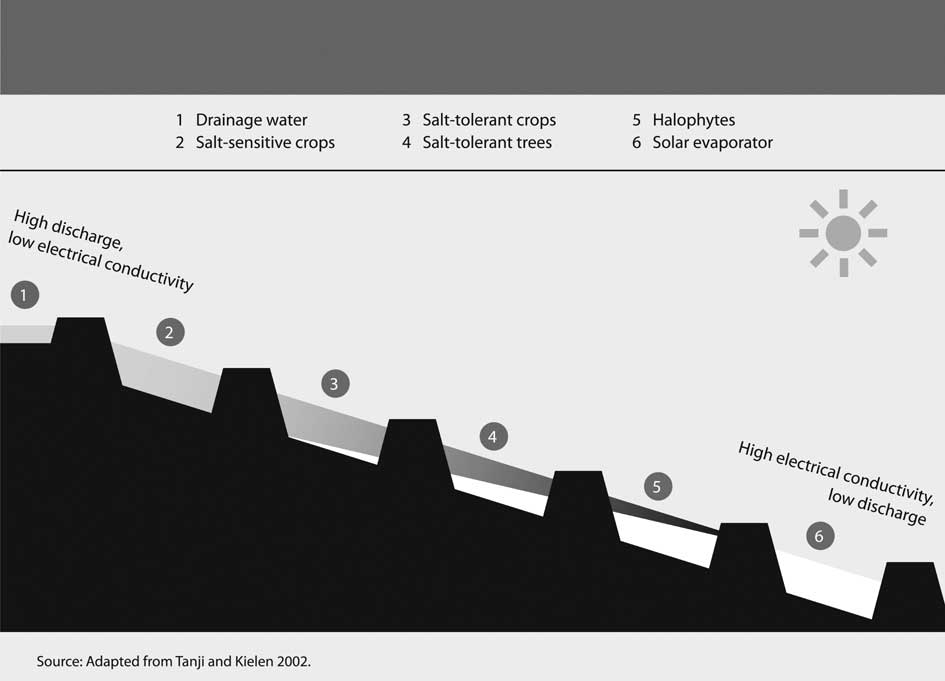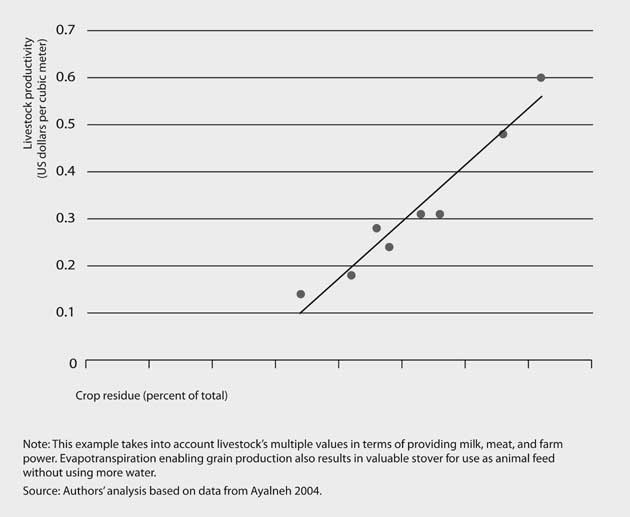
Figure 6-3. Sequential reuse of drainage water on drainage
affected lands. Source: Qadir et al., 2007.
Note: As proposed in the San Joaquin Valley drainage Implementation
Program, California.
resources, a recent assessment (Peden et al., 2007) describes four entry points to maximize investment returns in water and livestock in mixed systems:
• Improving the source of feeds; e.g., in low productivity mixed systems in Ethiopia, livestock water productivity increases as the share of animal diets composed of crop residues increases (Figure 6-4) (Peden et al., 2007);
• Enhancing animal productivity through traditional animal science interventions in nutrition, genetics, veterinary health, marketing and animal husbandry;
• Conserving water resources critically need for grazing management; and
• Providing sufficient drinking water; water deprivation reduces feed intake and lowers production. For lactat-ing cows water deprivation can greatly lower milk production (Staal et al., 2001).
While more research and site specific knowledge is needed, it is clear that securing improved outcomes in the development of agricultural water in the future will benefit from effective integration and consideration of animal use and their effect on water resources (Peden et al., 2007).
Fisheries. Fisheries can be enhanced in many existing and planned water management structures such as small dams, reservoirs, and impounded floodplains through stocking with appropriate species, greatly increasing productivity. Stocking technologies have produced high yields in lakes (Welcomme and Barley, 1998); in dams and reservoirs in Thailand, Indonesia, the Philippines and Malaysia (Fernando, 1977), in China (De Silva, 2003), and India (Sugunan and Katiha, 2004); and in floodplains in Hungary (Pinter, 1983), Bangladesh (Ahmed, 1998), and India (Sugunan and Sinha, 2001). Species introductions, and other enhancement technologies, such as fish holes, drain-in ponds, dugouts and finger ponds also effectively increase production (Dugan et al., 2007). Improved stocking management can increase production in integrated agriculture-aquaculture systems; a widespread type is integration of fish into rice paddies. While typically rice paddies produce 120-300 kg

Figure 6-4. Livestock water productivity relative to dietary crop residues and by-products in Ethiopia's Awash River Valley. Source:
Peden et al., 2007.
ha-1 yr- of mixed fish which contribute directly to household diets, managed fish stocking and harvest can increase rice yields (due to weed control and the aeration of soils) by some 10% while producing up to 1,500 kg ha-1 fish (de la Cruz, 1994; Halwart and Gupta, 2004).
Health and water management systems. Under conditions that allow control of water levels, such as irrigated areas, dry season irrigation in monsoon areas and on relatively free draining soils, water management techniques can bridge the gap between agricultural and health departments (Bakker et al., 1999). These techniques include alternate wet and dry irrigation; water saving irrigation technologies; modernization of infrastructure to minimize standing water and reduce sites for disease vector breeding; and organizational initiatives such as Water Users Associations and improved extension services. Banning the use of the most toxic pesticides and promoting integrated pest management (IPM) is a high priority for preventing poisoning via water (Eddleston et al., 2002). In this case, human health and environmental interests (reducing pesticide loads) are complimentary. In addition, operation of existing dams can be re-optimized to improve health and environmental performance, such as to restore floodplain ecosystems, and new irrigation schemes can be planned and designed to minimize environmental impacts (Faurés et al., 2007).
Biodiversity. Water resources infrastructure and agricultural landscapes can be managed to maintain biodiversity and other ecosystem services beyond production of food and fiber. Water resources infrastructure can be planned and implemented in ways that minimize the impact on the native biodiversity. Biodiversity concerns need to be addressed from the earliest stages of project planning; e.g., situating infrastructure in such a way as to avoid harming critical habitats (Ledec and Quintero, 2003). At the landscape scale, the spatial organization of tree and forest landscape